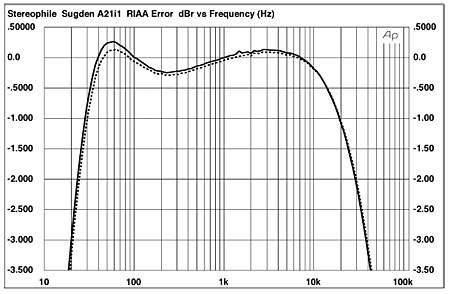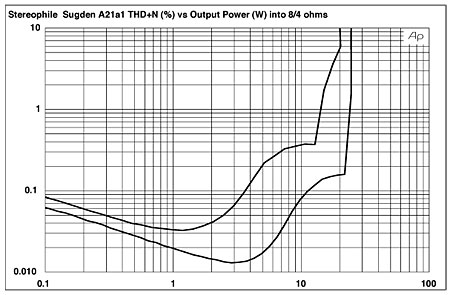| Columns Retired Columns & Blogs |
Sugden A21ai Series 2 integrated amplifier Measurements
Sidebar 3: Measurements
I primarily used Stereophile's loaner sample of the top-of-the-line Audio Precision SYS2722 system (see the January 2008 "As We See It" and www.ap.com) to examine the measured behavior of the Sugden A21ai Series 2; for some tests, I also used my vintage Audio Precision System One Dual Domain.
My first test of an amplifier is to run it for 60 minutes at one-third its specified power into 8 ohms, which is thermally the worst case for an amplifier with a class-B or -AB output stage. But a class-A amplifier is at its most efficient when delivering maximum power to the load. Running the Sugden with both channels at one-third clipping power into 8 ohms for one hour resulted in its side-mounted heatsinks reaching around 50°C (122°F). By contrast, letting the amplifier idle for an hour resulted in the heatsinks being too hot to touch; ie, >60°C (140°F). As Art Dudley said, this amplifier "runs hotter than hell's kitchenette."
The Sugden's maximum gain into 8 ohms was 38.25dB, 10.7dB of that coming from the preamplifier section. As Art suspected, the amplifier inverts absolute polarity from all inputs and outputs. The line input impedance was 24k ohms at low and middle frequencies, dropping slightly to 21k ohms at 20kHz. Set to moving-magnet operation, the phono-stage input impedance ranged from 44k ohms at 20Hz to 47k ohms at 1kHz and 42k ohms at 20kHz. Set to moving-coil mode, the input impedance was 40 ohms rather than the specified 100 ohms.
The MM phono stage gain was a little higher than the norm, at 45.2dB measured at the preamplifier output jacks; in MC mode, it was almost 20dB greater. The MM signal/noise ratio (ref. 5mV input at 1kHz) was good, at 54dB, unweighted, wideband, improving to 70dB when A-weighted. However, with the phono input set to MC mode, I couldn't eliminate a 120Hz hum that compromised the measurement. The phono stage's overload margin was very disappointing. In MC mode, ref. 500µV at 1kHz, it ranged from 9.7dB at 20Hz to 4.2dB at 1kHz and 6.5dB at 20kHz; in MM mode, the stage's distortion reached 1% at 4.1mV, which is lower than the 5mV at 1kHz reference level for MM cartridges. The margin was similarly poor at the frequency extremes, and equally disturbing was the fact that the phono stage latched once it was clipped: the signal remained clipped even if its level subsequently dropped a little.
The phono stage's frequency response is shown in fig.1; as well as the superb matching between channels, it features a fairly low ±0.25dB RIAA error between 40Hz and 12kHz, with the shape of the trace actually flattening the low-treble droop seen with many cartridges. The Sugden implements the IEC modification of the RIAA deemphasis, the low-frequency rolloff reaching –3dB at 20Hz. At the other end of the spectrum, the response is –1dB at 20Hz, –3dB at 38kHz.

Fig.1 Sugden A21ai Series 2, phono-stage RIAA error measured at preamp output jacks (0.5dB/vertical div., right channel dashed).
The A21ai has useful preamp-out jacks. However, these offer a very high source impedance of 6k ohms, though fortunately this figure doesn't change significantly across most of the audioband. The amplifier's output impedance from the speaker jacks was a low 0.12 ohm at 1kHz, rising to 0.39 ohm at 20Hz and 0.25 ohm at 20kHz. As a result, the modification of the amplifier's frequency response by the impedance of our standard simulated loudspeaker (see www.stereophile.com/reference/60) was low (fig.2, green trace), though the rolloff at the frequency extremes was more extreme into 2 ohms (gray) than into 8 ohms (blue, red), where it was down 1dB at 20kHz. The restricted ultrasonic response resulted in slowed-down leading edges of a 10kHz squarewave (fig.3). The shape of a 1kHz squarewave, however, was excellent (fig.4). These graphs were taken with the volume control at its maximum where the channel matching was excellent. At lower settings, however, a channel imbalance of up to 0.7dB was evident.

Fig.2 Sugden A21ai Series 2, frequency response at 2.83V into simulated loudspeaker load (green), 8 ohms (left channel blue, right red), 4 ohms (left cyan, right magenta), 2 ohms (gray). (1dB/vertical div.)

Fig.3 Sugden A21ai Series 2, small-signal 10kHz squarewave into 8 ohms.

Fig.4 Sugden A21ai Series 2, small-signal 1kHz squarewave into 8 ohms.
Channel separation via the line inputs was modest, at 54dB at 1kHz (L–R) and 66dB (R–L), though these figures remained relatively uniform across the audioband. Given that the amplifier's output stages are on opposite sides of the chassis, the crosstalk develops in the preamplifier section, probably at the volume-control potentiometer. S/N ratios (ref. 2.83V into 8 ohms), taken with the line input shorted but the volume control at its maximum, were good rather than great, at 60dB (wideband, unweighted) and 85.4dB (A-weighted).
The bottom trace in fig.5 shows how the THD+noise percentage in the Sugden's output varies with output power into 8 ohms with both channels driven. The distortion emerges from the noise floor at around 3W and rises steadily to 21W, where it rapidly increases. This increase is due to the tops of the waveform flattening, presumably because the signal can't go below the 0V ground reference. The amplifier reaches 1% THD+N at 24W, insignificantly lower than the specified 25W (14dBW). Into 4 ohms, however, not only did the overall distortion level rise significantly above 1W or so, the clipping power was only 15W (8.75dBW). I didn't measure the maximum output power into 2 ohms, as the amplifier was clearly in trouble with low impedances.

Fig.5 Sugden A21ai Series 2, distortion (%) vs 1kHz continuous output power into (from bottom to top): 8, 4 ohms.
This can also be clearly seen in fig.6, which plots the THD+N percentage into 8, 4, and 2 ohms at 2.83V. While the distortion is respectably low into 8 ohms (blue, red traces) and 4 ohms (cyan, magenta), it is catastrophically higher into 2 ohms (green). Fortunately, the harmonic content of the distortion is predominantly low-order in nature (fig.7), though higher-order harmonics are also present in a manner that descends more or less linearly with order (fig.8). The Sugden's behavior with the taxing high-frequency intermodulation test (fig.9) was okay, if not outstanding. At an output power just below visible clipping on the oscilloscope screen, the 1kHz difference component lies at –64dB (0.06%); though higher-order products are evident, these all lie at lower levels.

Fig.6 Sugden A21ai Series 2, THD+N (%) vs frequency at 2.83V into 8 ohms (left channel blue, right red), 4 ohms (left cyan, right magenta), 2 ohms (green).

Fig.7 Sugden A21ai Series 2, 1kHz waveform at 6.25W into 8 ohms (top), 0.039% THD+N; distortion and noise waveform with fundamental notched out (bottom, not to scale).

Fig.8 Sugden A21ai Series 2, spectrum of 50Hz sinewave, DC–1kHz, at 17W into 8 ohms (left channel blue, right red). (Linear frequency scale.)

Fig.9 Sugden A21ai Series 2, HF intermodulation spectrum, DC–24kHz, 19+20kHz at 20W peak into 8 ohms (linear frequency scale).
I am disappointed with the Sugden A21ai Series 2's measured performance. When I first became an audiophile in the late 1960s, the late Jim Sugden's class-A amplifier designs were already legendary. But the A21ai doesn't seem to take full advantage of the primary benefit of class-A operation, which is to allow the high standing-bias current to minimize distortion. Yes, its behavior into 8 ohms is respectable, but this amplifier really does not like impedances much below that figure. Its output-stage transfer function becomes increasingly "bent" as the load impedance drops, which will drastically limit the number of loudspeakers with which it will be able to successfully drive. Assuming there was nothing faulty with our review sample's phono stage, its miserable overload margin renders it incompatible with most moving-magnet and higher-output moving-coil cartridges. I recommend that, instead of the A21ai ($2995), vinyl lovers investigate using the line-only A21al Series 2 with an outboard phono stage from another manufacturer, though the recent price increase of the A21al from $1895 to $2795 makes that option less competitive.—John Atkinson
- Log in or register to post comments




































